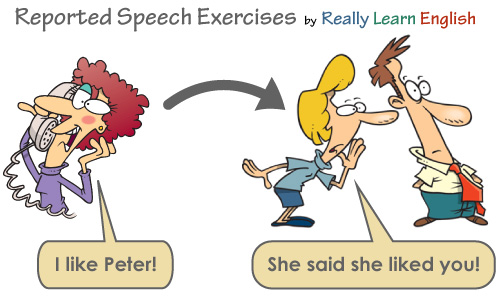If we report what another person has said, we usually do not use the speaker’s exact words (direct speech), but use reported (indirect) speech. You need to learn how to transform direct speech into reported speech. The structure is different depending on whether you want to transform a statement, question or request.



Direct and Reported Speech
Let’s start with an example:
Sam: ‘I’m having a shower.’
If you want to tell someone else what Sam said, you have two options:
Direct speech
a) You can repeat his words:
- Sam said, ‘I’m having a shower.’
This is called direct speech. (We use quotation marks to indicate direct speech.)
Reported speech
b) You can use reported speech:
- Sam said (that) he was having a shower. (‘that’ is optional)
‘Say’ and ‘Tell’
We can also use ‘tell’ in direct and reported speech.
Be careful with the grammar:
We usually use ‘tell’ with a personal object (often a personal pronoun):
- Sam told me, ‘I’m having a shower.’
- Sam told me (that) he was having a shower.
NOT: Sam told, ‘I’m having a shower.’
NOT: Sam told (that) he was having a shower.
We don’t usually use ‘say’ with a personal object:
- Sam said, ‘I’m having a shower.’
- Sam said (that) he was having a shower.
NOT: He said me, ‘I’m having a shower.’
NOT: He said me (that) he was having a shower.
NOT: He said me (that) he was having a shower.
Changing direct speech to reported speech
Reported speech is not really difficult. It is more a matter of logic and common sense. You probably have the same concept in your own language, where you use your own words to say what somebody has said or written.
Compare the examples:
- Sam said, ‘I’m having a shower.’
- Sam said (that) he was having a shower.
Apart from the punctuation, the two main differences are:
- the change of pronoun (‘I’ → ‘he’)
- the change of tense (‘Present Continuous’ → ‘Past Continuous’)
These types of changes are typical in reported speech. Learn more about them here.
Present tenses usually change to past tenses:
Present Simple → Past Simple
Present Continuous → Past Continuous
We use ‘if’ to introduce reported yes-no questions and questions with or. Find more details here.
Compare:
| direct question | indirect question |
| Do you like dogs? | I asked if she liked dogs. |
| Are you leaving now or are you staying for a bit longer? | He asked if I was leaving now or staying for a bit longer. |
| Note: However, it is not always necessary to change the tense. If the situation is still the same, you can leave verb in the present tense: – Sam: ‘I’m having a shower.’ If Sam is still in the shower when you tell someone else, you could say: – Sam said (that) he is having a shower. |
‘Tell’ or ‘Ask’ with Infinitives
We can also use ‘tell’ or ‘ask’ with infinitives for orders or requests:
Sam’s sister: Hurry up!
- She told him to hurry up.
- She asked him to hurry up.
The structures here are:
tell + someone + to do something
ask + someone + to do something
Sam’s sister: Don’t take too long!
- She told him not to take too long.
- She asked him not to take too long.
| In the negative: tell + someone + not + to do something ask + someone + not + to do something |
Here’s a funny video explaining the difference between direct and reported speech:
See also: